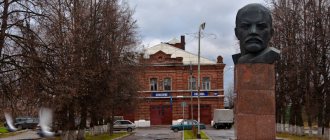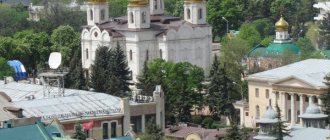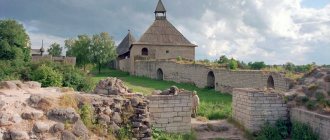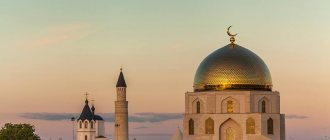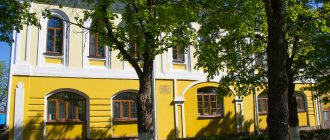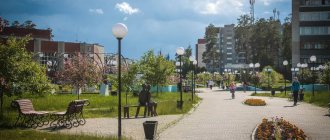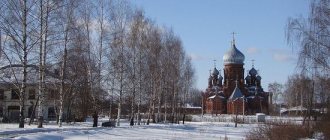Bridge over the Sinara River
The first stop is at the ancient stone bridge over the Sinara River still within the Chelyabinsk region .
It’s a mystery to me: how does all this hold up?!
For us geologists, the main value of the bridge is that it is made of granite with oxidized pyrite crystals.
Wonderful place...
What to see in Kamensk-Uralsky in one day: main attractions
Kamensk-Uralsky is the third largest city in the Sverdlovsk region. It arose from a settlement founded in 1682 by decree of Tsar Fyodor Alekseevich.
The need to found the future city arose when iron ore deposits were discovered on the banks of the Kamenka and Iset rivers. And the monks of the Dalmatovo monastery were the first to take advantage of the natural reserves, sending some of their peasants to this place and founding an iron mining plant.
A few years later, the plant and workers were seized by the state by order of Peter I. And on the site of the plant, the first iron foundry in Russia was founded.
- In this review of the main natural and historical attractions of the Sverdlovsk region, the most important things to include in your route to Kamensk-Uralsky.
- The easiest way to get to Kamensk-Uralsky is from Yekaterinburg, a hundred kilometers away, but it is also possible from Chelyabinsk, 180 kilometers away. Follow the links for guides to these cities.
Churches and temples
Cathedral of the Holy Trinity
The stone structure that appeared in the city at the beginning of the 19th century is atypical for the Urals. The temple is dedicated to eight saints - the only one in the region whose bell tower is crowned by a tetrahedral obelisk rather than a dome.
Previously, the church had a large territory on which there were trading shops, stables and a small cemetery. In 1918, all documents about births, deaths of residents and marriages were removed from the temple; the state separated the church by decree.
In the same year, the archpriest of the temple Vasily Pobedonostsev died as a martyr - he was hacked to death at the Sinar station. In 2000, he was canonized as a martyr.
In the early forties of the 20th century, the temple was used for training paratroopers, and a library and museum were built in it.
In 1990, the building was returned to the church in a ruined state, without a dome with an obelisk and whitewashed frescoes.
There is a large collection of icons from the 19th century, and an Orthodox school for children operates on Sundays. The icon of the holy righteous Simeon of Verkhoturye with a particle of his relics is constantly kept in the cathedral.
Church of the Intercession of the Mother of God
The Church of the Intercession of the Mother of God was built next to the cemetery for the funeral of the dead. The first name is Kamensk Cemetery Church. After consecration in 1885 it was renamed.
Two years after the appearance of the bell tower (1905), a parish was formed and a choir appeared. The Bolsheviks who came to power banned the church from holding funeral rites, and the cemetery was closed. It was decided to build a thermal power plant at the burial site, some of the remains were reburied, and the remaining graves were destroyed.
In the 30s of the 20th century, persecution of believers began. Soldiers fired cannon shots to prevent parishioners from praying; during church services, the first pioneers held their “religious processions” dressed as devils and priests. After the arrest of the church priest and his wife in 1934, services ceased, although the church did not officially close.
During the Great Patriotic War, the holy place turned into a prison. When N. Khrushchev came to power, a clothing warehouse was set up in the building.
Only in 1991 was the temple returned to parishioners in a destroyed state. Restoration continued until the 2000s, but during the renovation work the church did not stop its work.
Now there is a parochial school, an Orthodox library, and a children's playground. In 2012, in honor of the victory in the Patriotic War of 1812, a monument was erected on the territory - a sculpture of an angel.
The temple houses an icon of St. Panteleimon, the walls are decorated with frescoes of the 19th century.
Alexander Nevsky Chapel
The chapel was built as part of the Kamensk Belfry project for the 300th anniversary of the city. The author of the project was A. Dolgov.
In the bell tower of the temple there are nine bells, one of which was donated and smelted with the money of the townspeople. On July 4, 2001, the church was presented with an icon of Alexander Nevsky, painted by V. Vasnetsov in 1899!
Saint Alexander Nevsky is considered the guardian of the city. At the entrance of the temple there is a mosaic “The Savior Not Made by Hands”, the walls inside the building are painted with frescoes and icons.
In 2002, a memorial plaque was installed with the names of city residents who received the Order of Alexander Nevsky during the Great Patriotic War.
Nikolai Pyatkov Bell Factory
The plant is located near the temple, founded in 1991 by Nikolai Pyatkov. Bells from this plant ring not only in Russia, but also in the USA, Greece, Poland, CIS countries, Canada and Australia.
During the tour, they will show you the process of forging a bell tongue, polishing the finished bell, firing and pouring the mold, and talk about the history of bell production and the establishment of the plant.
Museum of Local Lore
Founded in 1924 by I. Ya. Styazhkin, who exhibited his private collections. The building itself was built in 1825; until the end of the 19th century, the Iron Foundry was located there.
In 1932 the museum became state-owned. The exhibits are represented by parts of excavations of ancient settlements found on the territory of the city, and objects of ancient life.
Pedestrian routes along Kamensk-Uralsky from the Tourism Center
Route No. 1. From the “Cannon” monument to Kirova Street.
You can walk or ride a bicycle. It will take about 2 hours, the length is about 2 km. On the route you will get acquainted with 14 objects.
The main ones are the “Cannon” monument (the symbol of Kamensk-Uralsky, installed in 1967), the Dam on Kamenka, the Holy Trinity Cathedral, the local history museum, the “Time Capsule” monument, a pedestrian staircase (made for the 300th anniversary of the city), architectural buildings that are monuments of regional significance. More details with addresses can be found here
Route No. 2. From the UAZ recreation center to the Butterfly bridge (walk through the Krasnogorsk district).
It will take you about 2-3 hours, the length is about 3 km.
On this route you will be introduced to 9 objects. These are the “Grieving Mother” memorial, the Eternal Flame, monuments, the “Baby Elephant” fountain, a park of culture and recreation, a pedestrian bridge over the Iset, the “White Stones” observation deck, and the “Butterfly” arched bridge. More details
Route No. 3. From the station to Leninsky Komsomol Square.
The walk lasts 2-3 hours, length - 3.5 km.
Includes 14 objects. These are the station, the monument-steam locomotive, the monument to the Sinara railway workers, the monument to Grigory Kunavin, the art object “Umka” and the lake “Seven Keys”, the motorcycle track “Youth”, the Walk of Fame, Leninsky Komsomol Square, the “Dandelion” fountain, the art object “ Bench of reconciliation", bench-monument to Peter I, Alexander Nevsky Chapel. More details about the route
Calendar of the brightest events of Kamensk-Uralsky 2022
Streets and monuments
Estates on Lenin Street
Lenina Street is the historical part of Kamensk-Uralsky - there are 19th-century estates built in the Baroque style.
Tourists can explore the estates of the Shamarins, Vorobyovs, and Zyryanovs.
The Zyryanov estate is distinguished from others by the uniform style of the residential building itself and the adjacent shop. The estate was built by a descendant of Peter Zyryanov, the city mayor of Yekaterinburg. The structure is an example of the eclectic style, favored by merchants for demonstrating luxury and status. The complex is built from local materials from two types of bricks.
And the Vorobyev estate was originally built for the merchant Kuznetsov, but he died before he could move into the mansion. His widow sold the unfinished house to bread merchant Alexander Vorobyov. It was under him that the house received a second floor and outbuildings. The Vorobyevs lived in the house until 1917 - after the revolution, their eldest son wrote a letter asking to give the estate to the authorities, and in 1926 the building was nationalized.
Also on this street there is a merchant's shop, which previously housed Red Army soldiers.
Walk of Fame
The Walk of Fame is dedicated to soldiers who died while serving in hot spots. The monument was opened in 2009.
The central place is occupied by an infantry fighting vehicle, installed with donations from citizens. After the installation of the BMP, the Walk of Fame was decorated with memorial signs of various branches of the military: Navy, Border Troops, Airborne Forces, Air Force and Air Defense.
Bench-monument to Peter I
The bench was a gift from V. R. Oberman to the city in 2016. The image of the emperor was taken from a monument in St. Petersburg, many saw it on the 500-ruble bill.
The monument bears the decree of Peter I on the start of construction of the Kamensk Iron Foundry. The bench to the Founding Tsar is located next to the Alexander Nevsky Chapel.
Sculpture "Moose"
The monument was erected on the banks of the Iset River on the territory of the Razgulyaevsky Forest Park.
Since its installation, the figure has been repainted five times. The appearance of the monument was facilitated by the arrival of a real moose in the city. Residents of the city believe that on Animal Protection Day, the Elk and the Deer, installed at the Tekhnikum stop, go for a walk.
Traveling around Iset
If you take a ride around Iset on a water bus, you can see three interesting objects at once.
Arched railway bridge "Butterfly"
This is an amazing single arch railway bridge. It was designed by Moscow engineer V.A. Rosnovsky. back in the late 1930s. Metal pipes with a diameter of 0.9 m are filled with concrete. This technology was no longer used in bridge construction. Included in the register of architectural monuments of the Soviet period.
Sculpture "Moose"
This moose appeared in the mid-1980s. The art object is located near the confluence of the Kamenka and Iset rivers. Author: Vladimir Permyakov.
Rock "Stone Gate"
A rock 20 m high with a through arch. A natural monument of regional significance, included in the list of specially protected areas in Russia.
What to see in Kamensk-Uralsky. Events poster for 2022
Residents call Kamensk-Uralsky an open-air museum. Natural sites, architectural monuments of regional significance, museums, art objects - all this can be viewed on your own.
For travelers around the Urals, we have compiled a short overview of the attractions of the city of Kamensk-Uralsky.
Reference. Kamensk-Uralsky is the third largest city in the Sverdlovsk region. The city began with a small settlement, which arose in 1682, when the monks of the Dolmatovsky monastery built the first blast furnace on the banks of the Kamenka River. In 1701, by decree of Peter I, the Kamensky state-owned iron smelting and iron foundry was built on the river bank. This year is considered the date of birth of Kamensk-Uralsky.
Natural attractions
Rock Stone Gate
A 20-meter-high natural creation is located on the banks of the Iset River. It was first described by the historian N. Popov.
The only rock in the city recognized as a monument of regional significance! The arch was formed as a result of the gradual destruction of limestone rock.
On the rock you can see ancient fossils - sea lilies, corals. Local residents consider this place to be the entrance to the world of the dead, but there is no explanation for this. A former resident of the Martyush settlement wrote in her diaries that almost every year people, mostly children, died on the rock.
The arch gradually goes under water, as can be seen from old photographs.
Threshold Howler
The threshold got its name because of the noise it makes, similar to a roar. The length is approximately 300 meters, the river bed is strewn with large boulders.
On one of the rocks surrounding the threshold, archaeologist V. Bushuev discovered the remains of petroglyphs.
In spring and summer, kayaking takes place on the rapids, rafting competitions take place, and climbers conquer the rocks.
Kodinsky warm spring
A unique natural creation - here, clean water always flows from a fault at a temperature of 18 degrees, and even in winter green grass grows around the spring.
The depth of the crack is more than 600 meters. The key contains the rare gas radon, and there are only 300 similar sources in the world.
You can drink water from the spring only after settling.
The spring is too small to build a resort, although local residents believe that the water from the spring cures heart disease. Previously, people used to wash and bathe in the spring.
